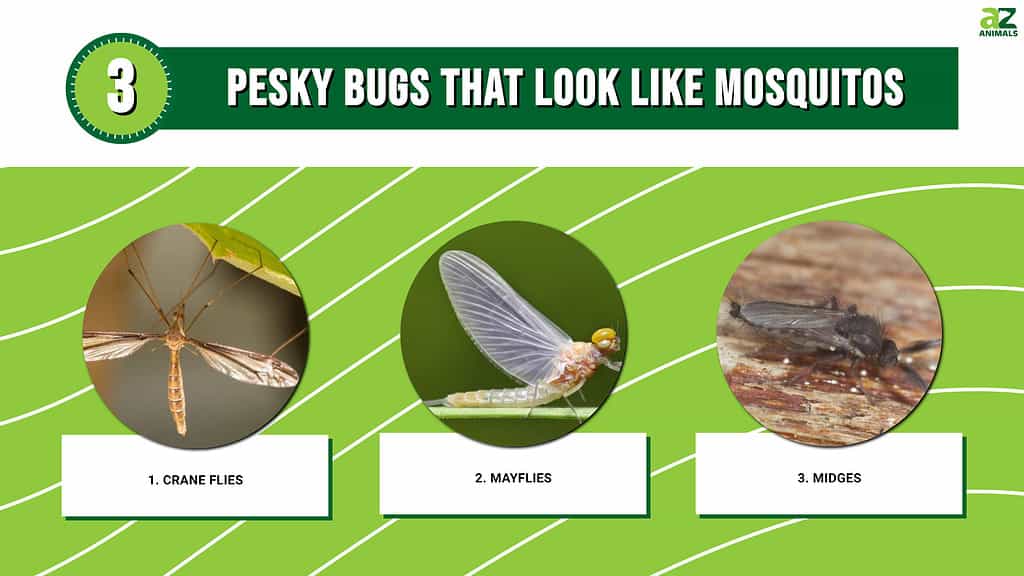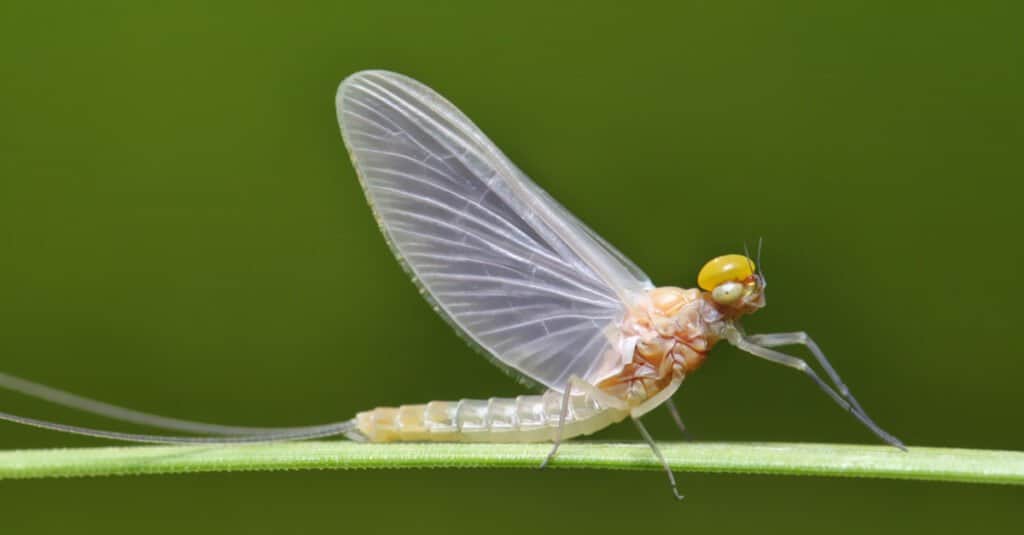Mosquitoes are some of the most widespread and annoying insects. They are known for their whining sounds, irritating bites, and being vectors of some deadly diseases. Mosquitoes can transmit diseases like malaria, the zika virus, and dengue fever. And without proper treatment, some of these diseases can be fatal for humans.
There are over 3,500 species of mosquitoes. So it is possible to mistake every annoying insect you encounter for a mosquito since some insects share similar characteristics.
This article will examine a few of these insects and provide tips on how to get rid of them.

1. Crane Flies

The cranefly is an insect from the
Tipulidaefamily.
©iStock.com/Aschen
Craneflies are insects from the Tipulidae family. They look like giant mosquitoes, and their behavior and appearance have earned them common local names like mosquito hawks, skeeter-eaters, and daddy longlegs. However, unlike mosquitoes, crane flies don’t feed on blood, nor do they bite.
Crane flies can be found almost everywhere in the world. This isn’t surprising since they belong to a family with over 15,000 species. They thrive in wet or moist places. However, the larvae of some species have been found in dry soil.
Some crane fly species, like the European and marsh crane flies, are considered agricultural pests. This is because of the significant damage they cause to farming crops. In people’s homes, they constitute a nuisance by their mere presence. However, crane flies have a significant ecological role, as they help break down and decompose organic materials essential for good soil.
How to Get Rid of Crane Flies
First, you must understand that adult crane flies are completely harmless to humans and plants. It is their larvae that pose the biggest threat to your plants. To get rid of them, you should do any of the following:
- Attract a cranefly’s natural predator to your garden or farm, like a bird or a spider. They will feed on the insects and help control their population.
- Avoid over-watering your garden, as this will create the perfect habitat for them to thrive.
- Spray plants with insecticides. There are commercial and natural options. Both are effective.
2. Mayflies

Mayflies are locally known as shadflies, fishflies, or Canadian soldiers in some parts of North America.
©Achkin/Shutterstock.com
Mayflies are aquatic insects, and they are locally known as shadflies, fishflies, or Canadian soldiers in some parts of North America. Globally, over 3,000 mayfly species live primarily in streams or other moist environments, and fish are among their main predators.
Mayflies are hemimetabolous. They start as eggs and become nymphs before growing into adults. In some species, the nymph transformation happens underwater.
Generally, the presence of mayflies in a river or stream indicates a healthy ecosystem. But because they arrive in swarms when the weather improves, they can be very annoying. However, mayflies are not harmful to humans. Still, there are things you can do to avoid inconveniences caused by the mayflies.
How to Get Rid of Mayflies
Mayflies are very important to aquatic ecosystems. So if reckless, your method of getting rid of them could end up causing a negative chain reaction that affects creatures that live in the water.
- Turn off your home’s exterior lights or change them to yellow lights. The heat emitted by the light attracts them, and turning it off will keep them away from your home, especially during their “peak” season.
- Although not officially confirmed, it is generally believed that the smell of garlic acts as a repellent for mayflies.
- Remove any stagnant water in your environment. Stagnant water encourages breeding; the more they breed, the greater their population.
3. Midges

The midges that bite are part of the
Ceratopogonidaefamily.
©Henrik Larsson/Shutterstock.com
Midges have much more in common with mosquitoes than the other two insects mentioned here. In appearance, they look like mosquitoes. Some species of midges also bite humans and transfer diseases, just like mosquitoes. However, these similarities do not make them mosquitoes.
The midges that bite are part of the Ceratopogonidae family, and they can be found almost everywhere except for dry arid areas or extremely cold locations. This species feeds on both humans and mammals.
Midges reproduce in aquatic environments, and their habits vary from species to species. However, although they are annoying and sometimes dangerous to humans and animals, they have ecological importance. Midges act as natural pollinators, which is good for agricultural yield, and they are also a good source of food for insectivores.
How to Get Rid of Midges
If you live in an environment where midges are abundant, you could face a lot of minor irritations depending on the species. You would also be exposed to certain types of diseases. Instead of just trying to get rid of these bugs, you should take preventative measures.
- Put stretched screens on the doors and windows of your home. These screens will make it difficult for the midges to get in. For your windows, you could use mosquito nets. These are usually laced with chemicals that repel most insects.
- Use bug repellents to keep them at bay. There are tons of options for you to choose from, many of which are great on your skin and environmentally friendly.
- Avoid having stagnant water around your home to discourage midge population growth. You should also keep rotten fruits and vegetables away from your habitat, as they attract midges.
The next time you get bugged by a bug, pay close attention to it before you call it a mosquito.
Summary of 3 Pesky Bugs That Look Like Mosquitos
| Number | Bug | How to Get Rid of Them |
|---|---|---|
| 1 | Crane Flies | Avoid overwatering; use insecticide on plants |
| 2 | Mayfly | Turn off exterior lights or use yellow lights; avoid stagnant water |
| 3 | Midge | Use screens on doors; use bug spray; avoid stagnant water |
The photo featured at the top of this post is © iStock.com/englishriver
Thank you for reading! Have some feedback for us? Contact the AZ Animals editorial team.






